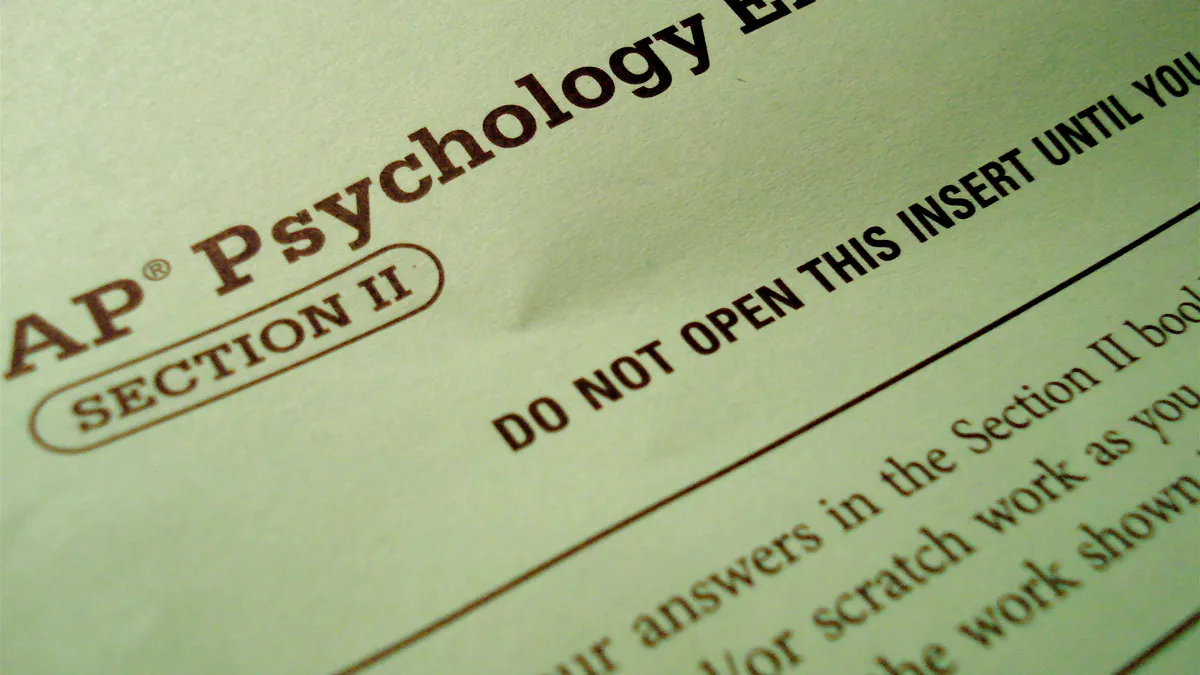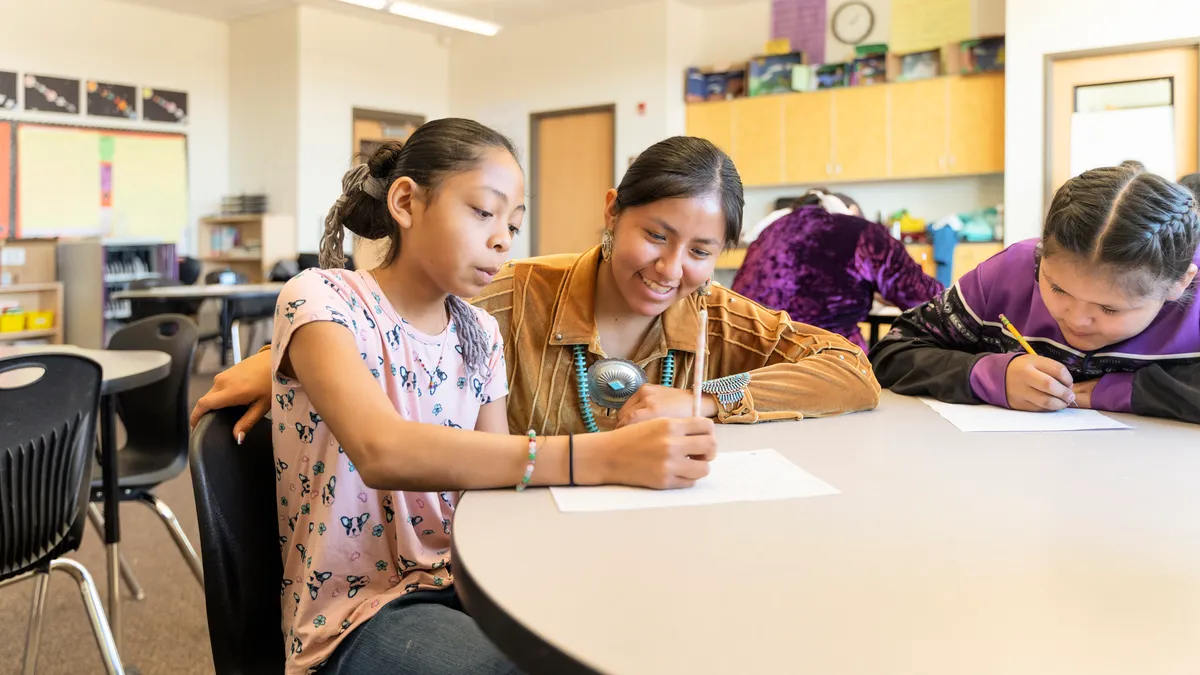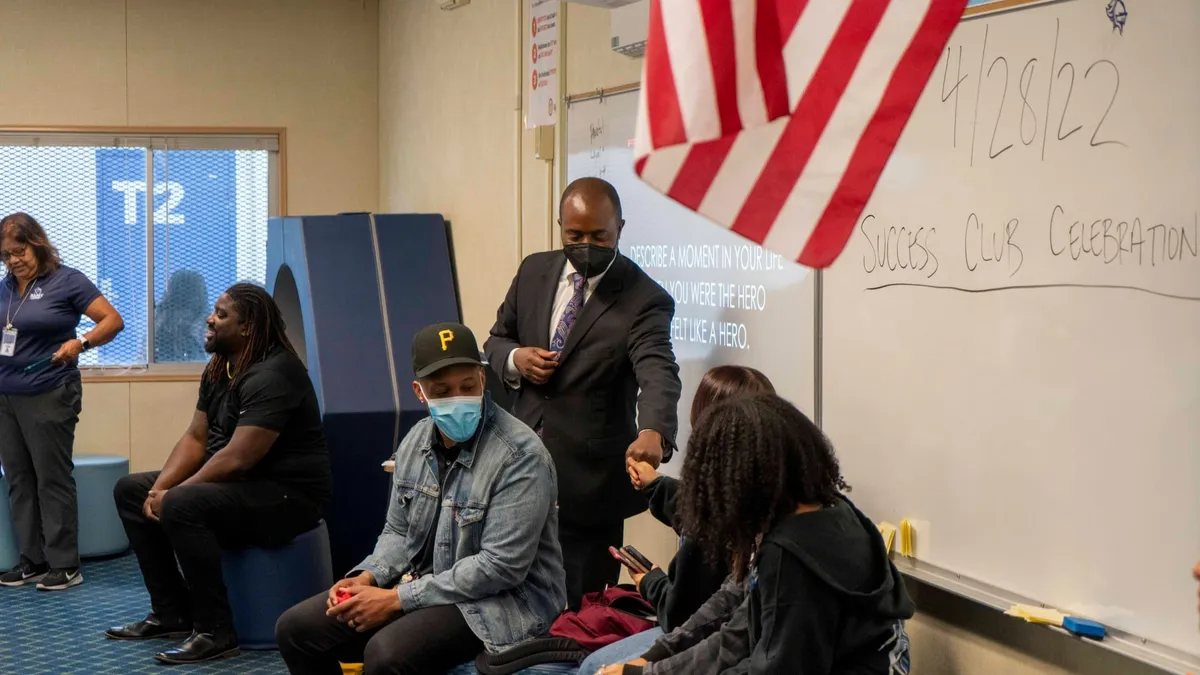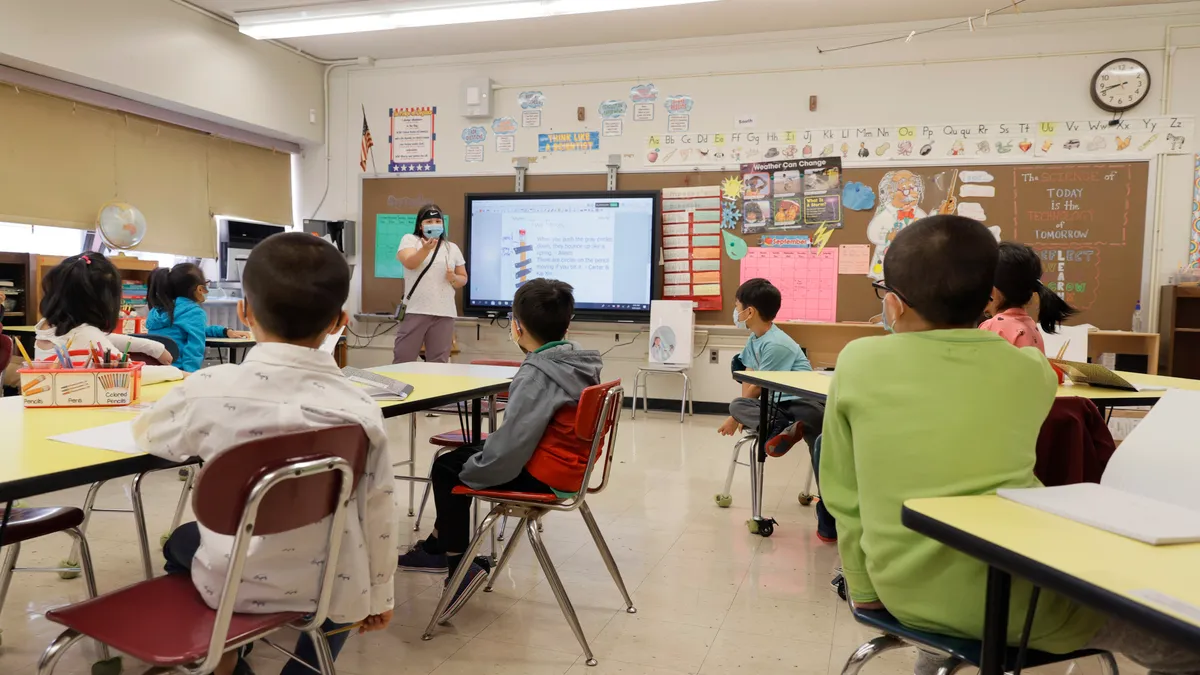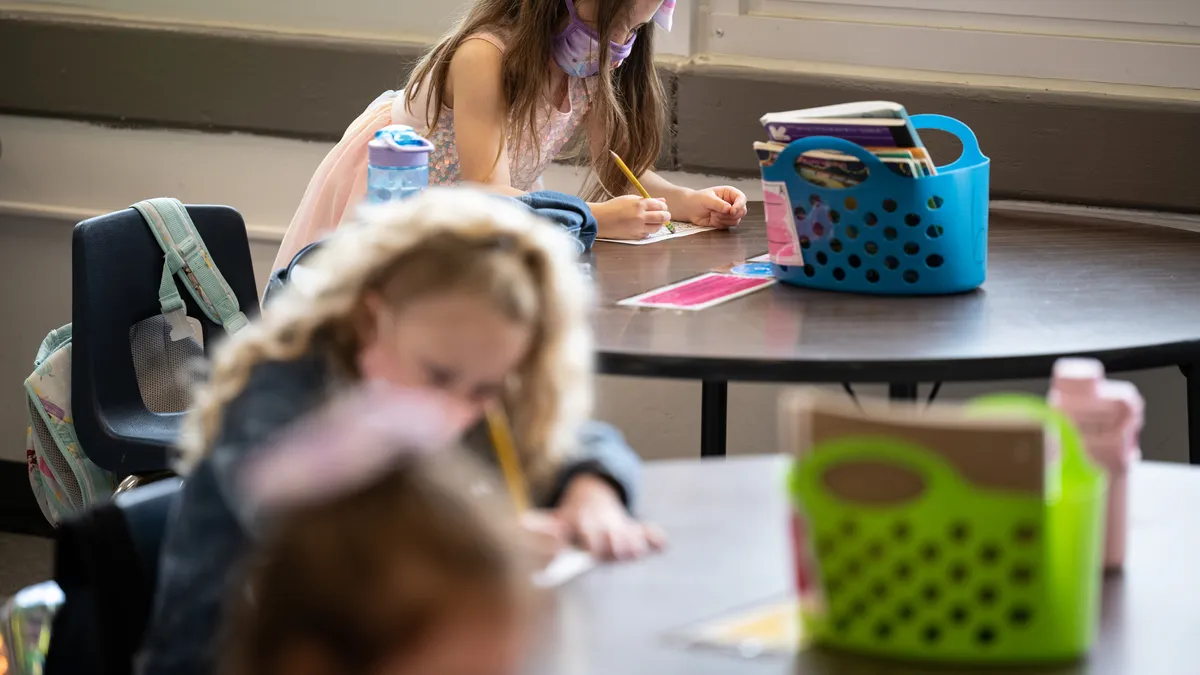This article is the third in a year-long series on the experiences of a new principal in the Prince George’s County Public Schools in Maryland. Read past installments here.
When David Brown was an assistant principal in Prince George’s County Public Schools, he regularly participated in "leadership development team" meetings along with his principal and other administrators, where he says he received “immediate feedback” on progress toward his goals.
Now halfway through his first year as principal at Hillcrest Heights Elementary School, a Title I school in Temple Hills, Maryland, he's making full use of that structure to stay on point and not waste his — or the teachers’ — time.
“So much of your work is rooted in meetings,” he says. “But I’m not leaving out of meetings saying, ‘I should have talked about this.’”
With the introductory period behind him — and with more chances, he says, to “peel back a layer of this onion” — Brown has shifted his attention from getting to know teachers to learning what they need to see academic growth in their students.
“I don’t want the principal’s office to be a one-way street where all edicts come down from on high,” Brown says. “That’s a quick way to lose people.”
He has tried to give every teacher 15 minutes of one-on-one time in which he covers the questions he has during the first half of the meeting, and the teachers gets the other half to talk about whatever is on their minds.
“I like to say, ‘one band, one harmonious sound’ — that's the goal,” Brown says. “If everybody's on the same page, it makes district requirements easier to achieve.”
But while he’s trying to give teachers a voice, he says he also wants to hear more than comments about feeling overwhelmed or having too much to do.
“If you give them an opportunity to reflect as peers — as content leaders — you get a little bit more,” he says.
A believer in processes, he asked members of the staff, starting with grade-level chairs, to complete a SWOT analysis, identifying strengths, weaknesses, opportunities and threats. What he took from that feedback is that if teachers need to improve their instruction, they need to improve how they plan their instruction.

Developing ‘good habits’
Brown’s efforts to get in sync with the teachers about how to improve student performance is supported by the RAND Corp.’s research on school leadership. As part of a 2012 evaluation of New Leaders, a New York City-based nonprofit that trains administrators through its Aspiring Principals program, researchers found “the actions that the principal takes to ensure buy-in are key ingredients to successful implementation of reforms.”
The study listed “conducting one-on-one meetings with all staff, respecting prior practices and culture, being visible in classrooms, and communicating clear and fair expectations” as among strategies that helped new principals lead improvement in their schools and gain support from teachers.
Hillcrest Heights 1st grade teacher Cynthia Jones says Brown has raised the level of accountability for teachers. He visits and observes classrooms regularly, and expects teachers to show up on time, not leave early and follow the curriculum. The most recent federal data available shows nine of the school’s 39 teachers missed more than 10 days out of the school year.
“He means what he says,” Jones says. “He will take down an out-of-date bulletin board and put it on your desk.”
And Brown has turned dismissal — which was chaotic — into an efficient routine. “Now it runs smoothly,” she says. “Loud, but smooth.”
As one of six districts participating in the Wallace Foundation’s five-year Principal Pipeline Initiative, an effort to improve the training and retention of principals, PGCPS has created a system of preparation and support programs that ensures new leaders like Brown develop “good habits as principals,” says Rodney Henderson, who leads the district’s Comprehensive Principal Induction Program, which supports new principals during their first two years. He’s also Brown’s go-to person when he needs some guidance.
At Hillcrest Heights, Henderson says Brown has an “opportunity to impact student achievement” and “build the capacity of his staff members.”
proficiency
Share of students who are proficient in each subject
After hearing from teachers, Brown spent a pot of money the school receives from Title I on professional development focused on lesson planning. Because most students at the school scored below proficient on state tests for multiple years, the district also makes content specialists available to work with teachers.
“He needs to make sure he manages all that,” Henderson says — taking the expertise the district is offering and complementing that with “some tailored PD within the building.”
While it’s still early, Brown says he has noticed more use of academic language in the classroom, and teachers are showing more comfort with the curriculum. By the end of the year, Brown hopes to see 7% to 8% growth in every grade level in both reading and math.
Asking the right questions
With a greater focus nationally on principals shifting the majority of their attention toward instruction rather than daily school operations, principals in PGPCS are also expected to offload some of their responsibilities “so they’re not just dealing with fires all day long,” Henderson says.
Brown has handled this process so well that, at a recent principal induction meeting, Henderson asked him to present how he identified staff members in his building to take the lead in areas that would otherwise keep him from visiting classrooms.
socioeconomic demographics
One of those areas was a new character education program Brown was hoping would be a vehicle for creating some incentives for good attendance. But because a lot of students are also tardy — and they still need to eat breakfast — the plan to hold those lessons as part of a morning meeting wasn’t working for every teacher.
“If you don’t ask the right questions, you never get the right answers,” Brown says. Now some classrooms focus on the topics, such as courage, honor and joy, before lunch.
Imani Cannon, a parent who has two children at Hillcrest Heights, says the school’s 7:45 a.m. start time contributes to absenteeism and late arrivals. But Brown has also added attendance parties — with music, dancing and board games — to reward students for not missing days or being late. Forty students earned the invitation to the first party. Then, in November, a second party was held and over 240 students were there.
“That's a significant difference,” Brown says, “all kind of powered by bringing … attention to the importance of attendance, providing kids with an opportunity to play and jump and be excited about being in school.”
Instead of on a monthly basis, Brown, Assistant Principal Sharon McNeil and the school’s counselor, Qiana Wright, now examine attendance data every two weeks to identify which students are missing three or more days, and which families should be contacted. In 2018, more than 20% of the school’s students missed at least 20 days, according to state data.
‘Learning what he’s about’
Brown is also building connections with parents and students — a factor research shows can reduce chronic absenteeism. While parents might receive official letters of warning about the number of days their children have missed, the new principal says he wants to add a “softer feel so parents don't feel attacked.”
In fact, focusing on school culture, particularly in schools with high mobility rates and other challenges related to socioeconomics — is a more recent component of PGCPS’ principal induction program, Henderson says. Principals are encouraged to do a “culture assessment” and maintain their focus on the school’s environment throughout the year.
Hillcrest Heights’ revamped arrival and dismissal process is one way Brown is doing that. He greets buses and cars in the morning and is outside to send them off in the afternoon.
“If you’re bringing your child to school, you have to see him,” Henderson says, “He’s present in the community and everyone knows who he is. They are learning what he’s about.”
Whether it’s grilling hot dogs for students who worked on a weekend clean-up and gardening day or wearing pajama pants during “Fall into Reading” night, Brown wants families to see him as someone who is not always “in a suit and walking the halls with a walkie talkie.”
When he does walk the halls and visit classrooms, some students greet him with high fives and familiarity. He's taken time to know their names and stories, and it shows. During a recent stop in the cafeteria as preschool students ate lunch, many of the children got up to hug him. He jokes that he has to be careful when wearing a white shirt, because the students will hug him no matter what's on their hands.
Cannon has known Brown for four years and says he “has always handled any situation or concern regarding a student that the parents have had in a timely manner.”
Brown also holds a monthly parent meeting, which tends to focus on their needs, such as employment or putting food on the table. The school’s parent liaison has formed relationships with local churches and community organizations, which provided Thanksgiving meals.
The school is also part of a larger district effort to implement social-emotional learning, which Brown feels is essential to helping students learn how to manage stress, handle frustration and solve problems.
“How do you embed strategies to get students to stop, think and then, if you're still having a problem, find an adult resource in this building to help you refocus and move forward?” Brown asks.
Using the Title I funds for PD meant Brown was not able to expand opportunities for after-school programs. While an after-school provider does serve Hillcrest Heights, it’s fee-based, and Cannon says the program is usually full by the second week of school.
The district has received state funds to launch at least 30 community schools, which will include coordinators to build partnerships with community organizations to address students' non-academic needs, but Hillcrest Heights won’t be among those for now. Still, Brown expects some after-school enrichment clubs, focusing on interests such as technology and dance, to begin meeting this spring. And the district, he says, is so large there are likely other sources of support for out-of-school-time programs he hasn’t explored.
“If you do not have, it’s because you have not asked,” he says.
Predicting ‘exponential growth’
When the RAND Corp. conducted its study on the Principal Pipeline Initiative, it collected data from the Maryland Department of Education on schools in PGCPS with newly placed principals. As with the other five districts in the initiative, the data showed students in such schools had higher math and reading scores than those in schools not affected by the initiative. The largest gains were also seen in the lowest-performing schools.
Henderson describes Brown’s goals for growth in achievement among Hillcrest Heights’ students — the 7% to 8% increase — as “ambitious.” But he’s also optimistic about the lasting impact of the Wallace Foundation’s initiative. The majority of the district’s principals are in their first five years as school leaders, and more than half have participated to some extent in the district’s leadership preparation programs.
“Once these principals mature and get past that three-year mark, that five-year mark, I think you’re going to see exponential growth in terms of what student achievement looks like,” Henderson says. “I think the true impact hasn’t been realized.”






